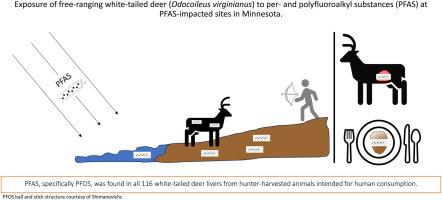自由放养的白尾鹿(Odocoileus virginianus)在明尼苏达州受PFAS影响的地点暴露于全氟和多氟烷基物质(PFAS)
IF 8.1
2区 环境科学与生态学
Q1 ENVIRONMENTAL SCIENCES
引用次数: 0
摘要
在环境污染地区为供人类食用而收获的野生动物可能对人类健康构成风险。我们评估了野生白尾鹿(Odocoileus virginianus)中全氟烷基和多氟烷基物质(PFAS)的水平,这是美国明尼苏达州的一种重要食物来源,猎人在三个受PFAS影响的地点附近捕获的鹿的肝脏样本(n = 116)进行了40种PFAS筛选。17种PFAS化合物在肝脏样本中至少检测到一次,其中100%的肝脏样本中发现了PFOS,超过50%的肝脏样本中检测到PFDA和PFBA。肝脏样品中检测到的7种PFAS浓度均高于1 ng/g(及其最大浓度)分别为PFOS (96.0 ng/g)、6:2 FTS (48.4 ng/g)、PFBA (9.14 ng/g)、NFDHA (5.75 ng/g)、PFOA (4.84 ng/g)、PFHxS (2.78 ng/g)和PFHpA (2.42 ng/g)。不同地点间PFAS浓度差异有统计学意义;在三个地点,PFAS的概况与已知或疑似PFAS来源大致一致。总PFAS浓度在鹿的生命阶段和性别组之间也存在差异,与成年雌性和雄性小鹿相比,成年雄性的总PFAS浓度明显更高。为了评估人类的消费潜力,当肝脏全氟辛烷磺酸达到≥20 ng/g的浓度阈值时,对成对的鹿肌肉样本进行了评估(n = 17个肌肉样本)。全氟辛烷磺酸是肌肉中最常检测到的全氟辛烷磺酸(检测频率为88%),肝脏中全氟辛烷磺酸的水平比配对肌肉组织中高约两个数量级。这些数据对于确定是否有必要采取公共卫生干预措施(如局部消费咨询)具有重要意义。本文章由计算机程序翻译,如有差异,请以英文原文为准。

Exposure of free-ranging white-tailed deer (Odocoileus virginianus) to per- and polyfluoroalkyl substances (PFAS) at PFAS-impacted sites in Minnesota
Wildlife harvested for human consumption in areas with environmental contamination may pose risks to human health. We assessed levels of per- and polyfluoroalkyl substances (PFAS) in wild white-tailed deer (Odocoileus virginianus), an important food source in Minnesota, U.S. Liver samples (n = 116) collected from deer harvested by hunters near three PFAS-impacted sites were screened for 40 PFAS. Seventeen PFAS compounds were detected at least once in liver samples, with PFOS found in 100 % of liver samples, and PFDA and PFBA detected in over 50 % of liver samples. The seven PFAS found in liver samples above 1 ng/g (and their maximum concentrations) were PFOS (96.0 ng/g), 6:2 FTS (48.4 ng/g), PFBA (9.14 ng/g), NFDHA (5.75 ng/g), PFOA (4.84 ng/g), PFHxS (2.78 ng/g), and PFHpA (2.42 ng/g). Statistically significant differences in PFAS concentrations were found between sites; PFAS profiles were generally consistent with the known or suspected PFAS sources at the three sites. Total PFAS concentrations also differed between deer life stage-sex groups, with adult males having significantly higher concentrations of total PFAS compared to adult females and male fawns. To assess human consumption potential, paired deer muscle samples were evaluated when liver PFOS reached a concentration threshold of ≥20 ng/g (n = 17 muscle samples). PFOS was the most frequently detected PFAS in muscle (88 % detection frequency), with PFOS liver levels approximately two orders of magnitude higher than in the paired muscle tissue. These data are important for determining if public health interventions, such as localized consumption advisories, are warranted.
求助全文
通过发布文献求助,成功后即可免费获取论文全文。
去求助
来源期刊

Chemosphere
环境科学-环境科学
CiteScore
15.80
自引率
8.00%
发文量
4975
审稿时长
3.4 months
期刊介绍:
Chemosphere, being an international multidisciplinary journal, is dedicated to publishing original communications and review articles on chemicals in the environment. The scope covers a wide range of topics, including the identification, quantification, behavior, fate, toxicology, treatment, and remediation of chemicals in the bio-, hydro-, litho-, and atmosphere, ensuring the broad dissemination of research in this field.
 求助内容:
求助内容: 应助结果提醒方式:
应助结果提醒方式:


